

Home | Spaceship Earth | Book Reviews | Buy a Book | Bean and Grain Index | Short Stories | Contact | Mud Blog
By Dan Armstrong
INTRODUCTION
The Food and Agriculture Organization of the United Nations called 2013 the year of quinoa. Referring to quinoa as a "climate-proof" crop, capable of adapting to a wide range of environments, the FAO is recommending quinoa as a high-protein staple crop to nations facing agricultural issues related to climate change or endemic food insecurity. Nations as varied in climatic conditions as Pakistan, Egypt, Denmark, England, and Australia are currently amid quinoa field trials to determine if quinoa can be grown in their region as a viable staple.
Pursuing the same line of reasoning as the FAO, the Southern Willamette Valley Bean and Grain Project, an ongoing effort to rebuild the western Oregon's food system through the increased production of organic, locally grown and locally consumed staple crops, has been exploring the potential of growing quinoa in western Oregon for several years. This paper describes recent Southern Willamette Valley Bean and Grain Project research aimed at evaluating quinoa as a commercial production crop in the Willamette Valley.
ABSTRACT
Chenopodium quinoa has been grown in the Willamette Valley on a very limited basis for more than thirty years, but only for specialty seed production or as a source of salad greens, never as a commercial staple crop. There are several reasons for this, some related to the local market and some related to production. This paper explores several of the production related issues.
The primary production issues for growing quinoa commercially in the Willamette Valley are (1) the prevalence of lygus bugs in the Willamette Valley; (2) air moisture increases beginning in September; and (3) quinoa pollination viability when ambient air temperatures exceed 94 degrees Fahrenheit.
1. The lygus bug is prevalent in the Willamette Valley in high populations largely due to the valley's five hundred thousand-acre grass seed industry. The lygus bug becomes most dangerous to quinoa after the Willamette Valley grass seed harvest in mid-July, when the lygus bugs disperse from the grass seed fields to other plant varieties in the valley, including quinoa. The lygus bug sucks the moisture from the immature quinoa seed and can cause considerable reduction in yield.
2. Quinoa grown in the Willamette Valley has generally been planted near the first of May with harvest in early September. September harvest is problematic because air moisture levels increase radically in September, bringing heavier morning dew and a greater likelihood of rain, both of which can lead to mold problems if the seed is still in the field.
3. Quinoa pollen fertilization rates have been found to decrease when ambient air temperatures exceed 94 degrees Fahrenheit. In the Willamette Valley temperatures generally do not exceed 94 degrees Fahrenheit until mid-July and with increasing likelihood through the end of August.
Finding a quinoa variety with a shorter life cycle or the capacity to be planted earlier in the season, thus enabling harvest by August 1, could possibly minimize lygus bug damage, avoid the high ambient air temperatures of August, and escape the moisture issues of September. This research project was designed to explore the advantages, if any, of an earlier planting date.
MATERIALS AND METHODS
Field tests were conducted in Eugene, Oregon at the south end of the Willamette Valley from October 2013 to September 2014. The test plot soil quality was moderate to low, with a high clay content. Liquid fish fertilizer and kelp were applied once to mature plants on May 10. No other fertilization inputs, herbicides, or pesticides were used. Plants were sparingly irrigated from mid-June to August 4.
The research project used seven varieties of C. quinoa: one variety that has been grown for five years at the test plot location (Dan 2013), three varieties that came from Willamette Valley seed breeder Frank Morton (Cherry Vanilla, French Vanilla, Brightest Brilliant Rainbow), one variety that came from the island of Chloe in Chile (Chadmo), and two varieties that came from the USDA seed bank at Iowa State (PI 614880, PI 634919).
The experiment design was as simple as possible. Six of the seven C. quinoa seed varieties listed above (Brightest Brilliant Rainbow excluded) were planted (5 to 35 seeds) on the following dates: October 19, November 17, December 19, January 19, February 16, March 15, and April 19. Four varieties (Cherry Vanilla, Brightest Brilliant Rainbow, Chadmo, and PI634919) were planted (5 to 45 seeds) on May 12. All seeds were planted by directly placing the seed into the soil. On May 19, two varieties, PI614880 and PI634919, were planted in pots and grown to six inches height in a greenhouse. They were transplanted into test plots on June 14.
The experiment sought mature seed from all plants that reached harvest, with special interest in seed from the earliest plantings and/or plants with the shortest life cycles (planting to harvest).
OBSERVATIONS AND RESULTS
Weather: The weather experienced in the south Willamette Valley during the one hundred days from November 20, 2013 to February 28, 2014 was unexpectedly cold. Temperatures below 25 degrees Fahrenheit are rare in the Willamette Valley. Ten such days in an entire winter would be a high number. During the one hundred days of interest, sixty had lows of 32 degrees F or below. Twenty-five experienced temperatures at or below 25 degrees F. Five days experienced temperatures at or below 10 degrees F.
Snow fall is normally very light in the Willamette Valley. Accumulations of more than four inches are unusual and rarely occur more than once or twice a winter. Snow fall in excess of ten inches occurred on December 5 and on February 6. The February snow was followed by an ice storm and a full week of below freezing temperatures. This was all very unusual for the region. Anecdotally, this was coldest winter in forty years.
The summer was also extreme. Though air temperatures exceeded 94 degrees F only two times during the summer (95 degrees F on July 28 and 98 degrees F on August 12), ambient air temperatures reached 90 degrees F or higher one third of the days between June 1 and September 10.
Between May 19 and September 1, it rained half an inch over a three day stretch from June 27 to 29. No other rain was experienced in that time frame.
Germination: Though the winter was extremely cold, approximately five percent of all seeds planted between October 19 and March 15 did germinate. Some seed germinated in every month. All varieties germinated, again in low percentages, in October, February (after the snow melt), and March. Only one germinated seed (Chadmo from the March 15 planting) survived more than three weeks. Most died after two weeks. Images below show C. quinoa sprouts from October and January.
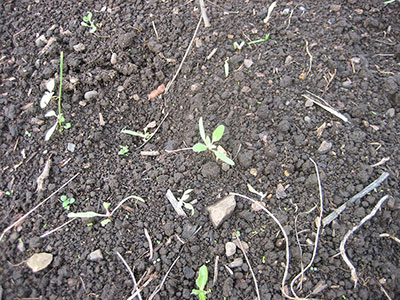
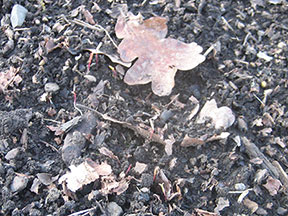
In the first week of April, there was a large bloom of Chenopodium album. It appeared in all test plots. The C. album sprouts look very much like C. quinoa. In the first week, they are nearly impossible to differentiate. This made plot germination monitoring especially difficult. Due to this problem, all sprouts, C. quinoa and C. album, were allowed to grown until differentiation was possible. All C. album was pulled prior to seed production.
In April ambient air temperatures ranged from 39 degrees to 73 degrees F. All six varieties planted on April 19 germinated at a rate of more than 75%. Just under 50% of the seeds planted survived to harvest.
In May ambient air temperatures ranged from 41 degrees to 75 degrees F. All varieties germinated at a rate of 75% or greater. Approximately 60% of the seeds planted survived to harvest.
Earliest Plant Survival: The earliest planting to create mature seed came from the chadmo variety planted on March 15. One seed grew into a very healthy plant, reaching six feet in height, with many thick side branches and at least twenty full panicles. The plant was harvested August 21, giving it a life cycle duration of 158 days. Images below show this plant in late June and mid-July.
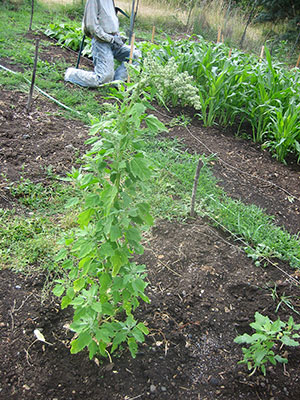
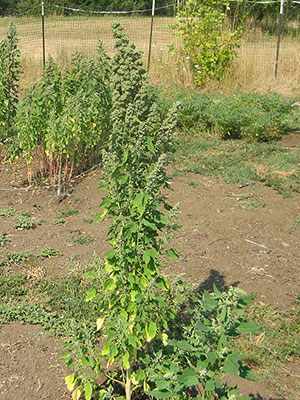
Summary of Plant Survival: All varieties planted in April and May produced plants that survived to harvest, except the April 15 planting of PI614880. All plants from all plantings were green except one purple plant in the Chadmo May 19 planting.
| Planting Date | Variety | Seeds planted/harvested | Harvest Date | Life Cycle |
|---|---|---|---|---|
| March 15 | Chadmo | 25/1 | August 21 | 158 days |
| April 15 | Dan 2013 | 5/1 | August 8 | 115 days |
| April 15 | Cherry Vanilla | 30/7 | August 8 | 115 days |
| April 15 | PI634919 | 10/5 | August 21 | 128 days |
| April 15 | French Vanilla | 30/25 | August 12 | 119 days |
| April 15 | Chadmo | 30/25 | August 21 | 128 days |
| May 12 | Cherry Vanilla | 45/35 | August 18 | 98 days |
| May 12 | Br. Br. Rainbow | 15/6 | August 22 | 102 days |
| May 12 | Chadmo | 35/25 | September 1 | 112 days |
| May 12 | PI634919 | 6/1 | August 28 | 109 days |
| May 19 | PI634919 | 4/2 | September 1 | 105 days |
| May 19 | PI614880 | 2/1 | August 28 | 105 days |
Lygus Bug Population: The first lygus bugs were spotted in low numbers in the April 15 plot on June 16. Plant inspection on June 24 revealed a slight increase in the lygus bug population. Lygus bugs were not present in all plots; however, cucumber beetles and earwigs, in low populations, were also on several plants.
Rain over three days–June 27 to June 29–caused a diminishing of the lygus bug population, but plant inspection on July 17 showed a vast increase in the lygus bug population. (A small dent was made in the population by removing the bugs from the plants by hand.) Plant inspection on July 23 shows slight decrease in lygus bug population, but plant damage by birds (bushtits) was evident.
The lygus bug population was radically diminished by August 1. Bushtits, which continued to inflict damage on the plants, could have eaten them. All plants were covered by bird netting on August 4. From that point on the lygus bug population showed an increase. All quinoa harvested after August 12 showed high lygus bug populations, mostly immature (green) insects. Images below show two kinds of netting methods for protecting plants. One uses bird netting; one uses mosquito netting. Both worked. The netting, however, resulted in a few bird deaths.
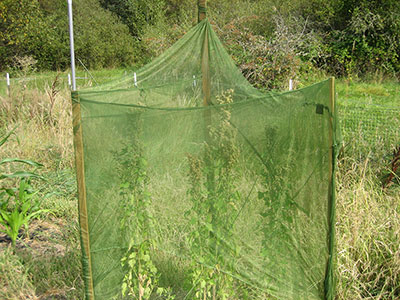
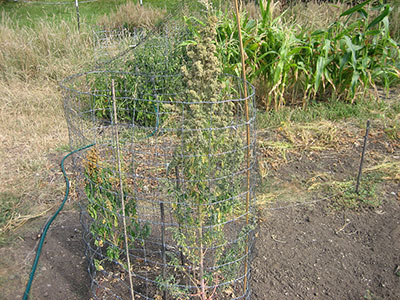
Birds: Birds were an unexpected problem. It was thought that the saponin coating on the seed would deter bird interest; however, the local bushtits seemed to like the seed anyway. They would come to the test plots twice a day in flocks of fifty or more to feast on the quinoa plants, causing more damage to the plants than the lygus bugs. The bushtits may have been eating the lygus bugs as well as the seed. Images below show evidence of bird damage.
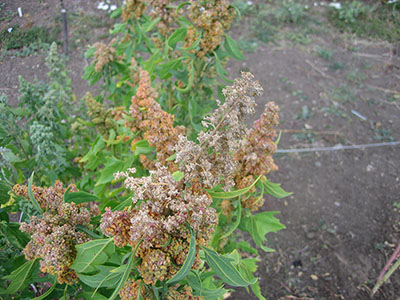
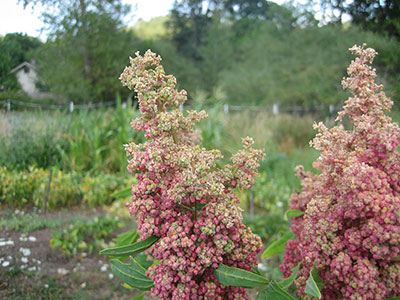
Bird protection for the quinoa was added on August 4. During first few days, several birds got caught in netting and died. Within a week, bushtits had no impact on the plants. It should be noted that other quinoa test plots in the south Willamette Valley managed by Oregon State University in 2014 also experienced bird damage. Bird damage was also noted in 1991 during quinoa research in England.
Curly Leaf: Several of the quinoa plants suffered from curling leaves. All seed varieties but Dan 2013, French Vanilla, and Brightest Brilliant Rainbow showed some curling leaves. Plants with high percentages of curling leaves were culled from the plots. Plants with lower percentages of curling leaves had those leaves removed. Curling leaves also appeared on approximately 5-10% of the C. album. Images below show curling leaves on two different plants.
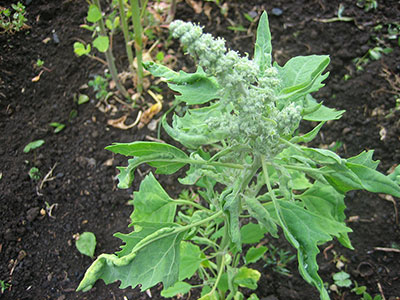
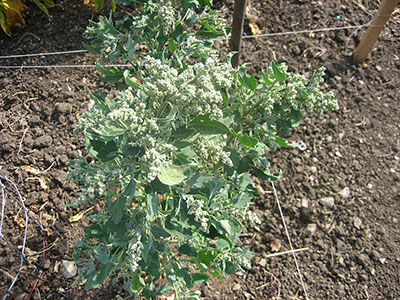
Chenopodium album: Chenopodium album was a big problem. All test plots were filled with it, and it was impossible to differentiate C. album sprouts from C. quinoa sprouts. Through the summer, it became obvious that the C. album grew much faster than C. quinoa. The C. album lifecycle is approximately 60 days, compared to 100 plus days for the C. quinoa. A two-week old C. quinoa plant is little more than a one to two-inch tall sprout–two cotyledons and two leaves, while the two-week old C. album plant is four to eight inches tall with eight to sixteen leaves. Images below show several C. album sprouts and a large patch of C. album.
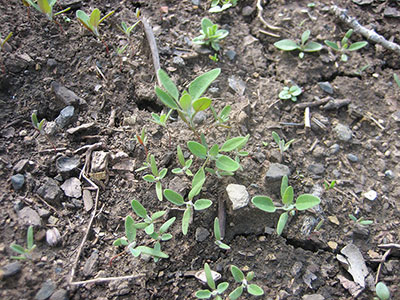
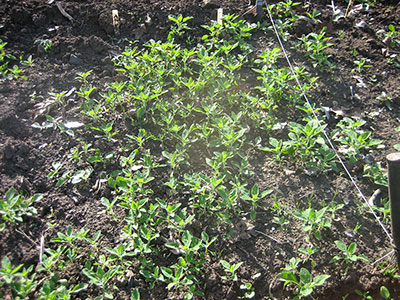
DISCUSSION
The fall and winter plantings (October through February) demonstrated that C. quinoa seed germination can occur during unfavorable weather conditions and in soil below 40 degrees F. That said, none of seeds germinated in this period produced sprouts that survived longer than three weeks. It appears that the C. quinoa sprout is simply too fragile and slow growing for any hope of over-wintering. The sprouts were able to withstand a frost or two, but not three, especially when combined with a steady diet of clouds and temperatures below 50 degrees F.
The spring plantings (March, April, and May) had entirely different results. One plant (chadmo) from the March planting survived to harvest and became a healthy plant. This plant's early planting date, however, did not correlate to an earlier harvest date. Quinoa planted April 19 was harvested between August 8 and August 21, resulting in a life cycle of 115 to 128 days. The lone March 15 survivor was harvested on August 21, giving it a lifecycle of 158 days. Curiously enough, the April chadmo planting was harvested the same day as the March chadmo planting.
If harvest date is the most important criterion, there was no advantage to the March planting date for the chadmo variety.
This judgment is further supported by the fact that the seed to harvest success rate for the Marching planting was less than one percent, while the success rate for the April planting was just below fifty percent. The May planting success rate was somewhat higher at sixty percent, with a harvest date one week to ten days later than the April planting. Here the trade-off between a slightly lower success rate and slightly earlier harvest favors the April planting.
All of the quinoa planted in the 47-day window (March 15 to May 12) was harvested between August 8 and September 1, a span of 24 days, suggesting an earlier planting date does not translate directly to an earlier harvest and also seems to extend the life cycle duration.
Judging from this single-year of research, the optimum planting window for C. quinoa in the Willamette Valley appears to be between April 1 and May 1, with a leaning toward the beginning of April. (It should be added that C. quinoa test plots planted in 2013 and 2014 by Oregon State University in the Willamette Valley support this thesis. Both years, the quinoa was planted in early April with a high rate of successful plants and a harvest date before September 1.)
The earliest harvest was August 8. The seed heads were not completely dry when harvested. The final drying took place in a greenhouse. In light of concerns for lygus bug infestation, temperatures in excess of 94 degrees F, and air moisture content in September, the theorized window for optimized harvest–July 15 to August 1–was missed by approximately one week. These results are positive enough to continue this research. A second-year experiment will be conducted during the 2014-15 growing season with seed from 2013-14 test plots, a few additional C. quinoa varieties, and some variation in method.
The prevalence of Chenopodium album in the Willamette Valley was a major problem, and should be added to the list of C. quinoa production issues. The spontaneous and prolific germination of C. album in the first week of April, however, is worth noting. It suggests that the last week of March could be an "early limit" for planting Chenopodiums in the Willamette Valley.
Bushtits were also a major problem and should also be added to the list of C. quinoa production issues in the Willamette Valley. In the specific instance of this research project, bushtits were a bigger problem than lygus bugs. The bird netting was effective, however, netting of the plants adds cost and inconvenience to C. quinoa production. Images below show the April 15 and the May 12 test plots in early August.
SUMMARY
Chenopodium quinoa can be grown in the Willamette Valley and harvested before September 1. An August 1 harvest date seems possible, but has not yet been achieved. Bird (bushtit) and insect (lygus bugs) damage offer more difficult problems. The August 1 harvest goal is likely to help with lygus bugs, but the bird damage remains problematic. Though the potential is clearly evident, more research is necessary before recommending large scale C. quinoa production to farmers in the Willamette Valley.
OTHER QUINOA RESEARCH
There has been increased interest in growing quinoa in the Willamette Valley over the past few years. The Marion-Polk Food Share/Oregon State Extension planted mulit-acre quinoa plots in 2013 and 2014. The results from their 2014 planting are summarized in this report. The Berggren Demonstration Farm in Springfield, Oregon planted a fifth acre of quinoa in 2014. Sam Madge managed this plot. A summary of the project is availale on the farm's website.
ACKNOWLEDGMENTS
This project would not have been possible without the much appreciated intellectual and material support from David Brenner at the Plant Introduction Center at Iowa State University, Daniel Bertero at Universidad de Buenos Aires, and Kevin Murphy at Washington State University. A conversation with Daniel Bertero at the 2013 Quinoa Conference in Pullman Washington inspired this research project. Special thanks to Daniel.